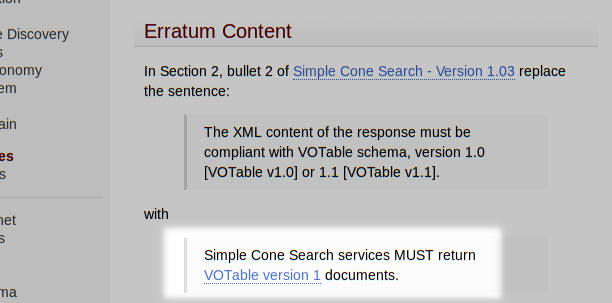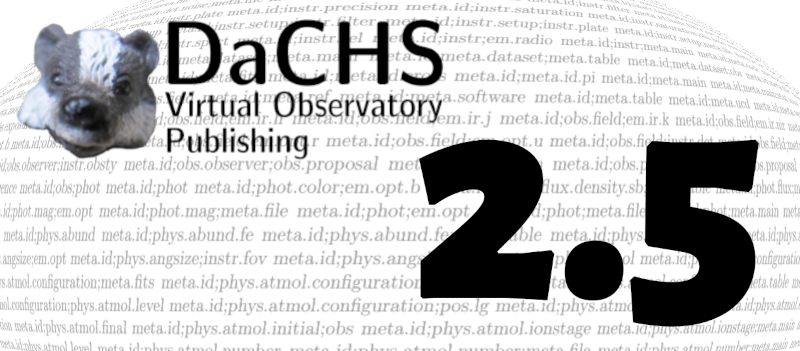Small Change, Big Win

That's SCS 1.03 Erratum 2 rendered in my browser with a bit of image processing to celebrate that there's one painful VO legacy less on this world.
PSA: what follows is VO lore that may be entertaining but will not help you use or publish astronomical data.
Today, I've made a very small commit to my VO publication package DaCHS (revision 8452):
--- gavo/web/vodal.py (revision 8451)
+++ gavo/web/vodal.py (working copy)
@@ -260,7 +260,6 @@
version = "1.0"
parameterStyle = "dali"
standardId = "ivo://ivoa.net/std/ConeSearch"
- defaultOutputFormat = "votable1.1"
One deleted line, small cause, huge effect.
This story starts with the oldest „operational“ VO standard, Simple Cone Search, which was formally published in 2008 but really got its current shape a lot earlier.
I've not been there back then, but I think the authors expected that clients would be parsing the VOTables that the services were returning using something called XML binding. That, well, was a technique where code was generated from an XML schema, and only instance documents conforming to that exact schema could be parsed with that code.
That is of course the opposite of the golden rule of interoperability (“be strict in what you produce and lenient in what you accept”) and thus would have been a terrible implementation choice for interoperable clients (and I believe nobody ever tried it). But somehow – or that is my explanation – the XML binding reasoning translated into the requirement that SCS services could only return VOTable 1.0 or VOTable 1.1, and that made it into the standard. It was hence the law. And that it DaCHS had to keep alive VOTable 1.1 for writing (which the above commit of course doesn't remove, but I can remove it now any time I feel like it). And that it couldn't do a lot of useful things that required features not present in VOTable 1.1.
Nobody dared to touch the problem for about a decade, as it was actually unclear whether some ancient code might still be doing useful work with SCS and XML binding. And I shouldn't be scoulding them after I have recently broken ESO examples under the assumption that “aw, nobody's gonna do this“. Then, starting about five years ago, we had a couple of discussions at various conferences about how we might bring SCS into the present VO (where it, it has to be said, sticks out a bit for several other reasons, too, like its funky error reporting and the funny UCDs it uses). But these weren't easy: What exactly are we allowed to break within a minor version under the above assumption (“aw, nobody… “)? If we do a major version, how do we plan for co-existence for two parallel major version?
Well: For the version restriction, in the end a simple Erratum was enough. On January 26, 2022, the IVOA Technical Coordination Group accepted SCS 1.03 Erratum 2. And now I can return whatever VOTable version suits me. Phewy.
I can now have GROUPs in GROUPs (which I need to annotate photometry), I can finally return tables with my old proposal for STC in VOTable in SCS results (where they would have mattered most – not that anyone cares any more, as that ship has sailed somewhere completely different).
Hey, I can have xtypes. Doesn't mean anything to you? Well, try this: In TOPCAT, open VO/Cone Search. Type “Constellations” and select the “cslt cone“ service. Run a query for some part of the sky, with a size of a few 10s of degrees. Open a sky plot, and in there, do Layers → Add Area Control, and in that control select the table you have just pulled in. Presto: You'll see the constellation boundaries without further configuration, and that's because TOPCAT has the xtype to figure out that the odd numbers it sees are really the vertex coordinates of a spherical polygon in DALI serialisation.
Not a big deal, you say? Perhaps. But lots of small deals accumulated make the difference between what you can do and what you cannot, in particular across services (which is what the VO is about).
Removing the erroneous constraint on VOTable versions in SCS opened the standard up for quite a few small deals. Thanks, TCG!

![[RSS]](./theme/image/rss.png)

